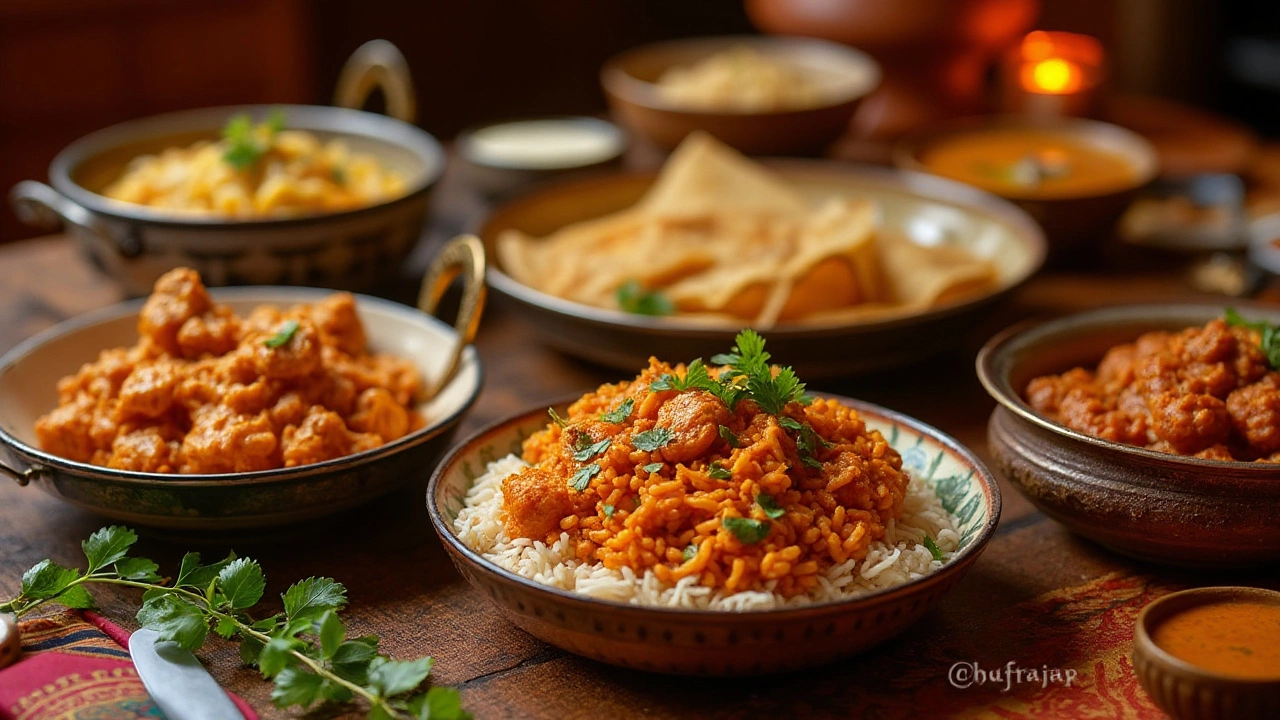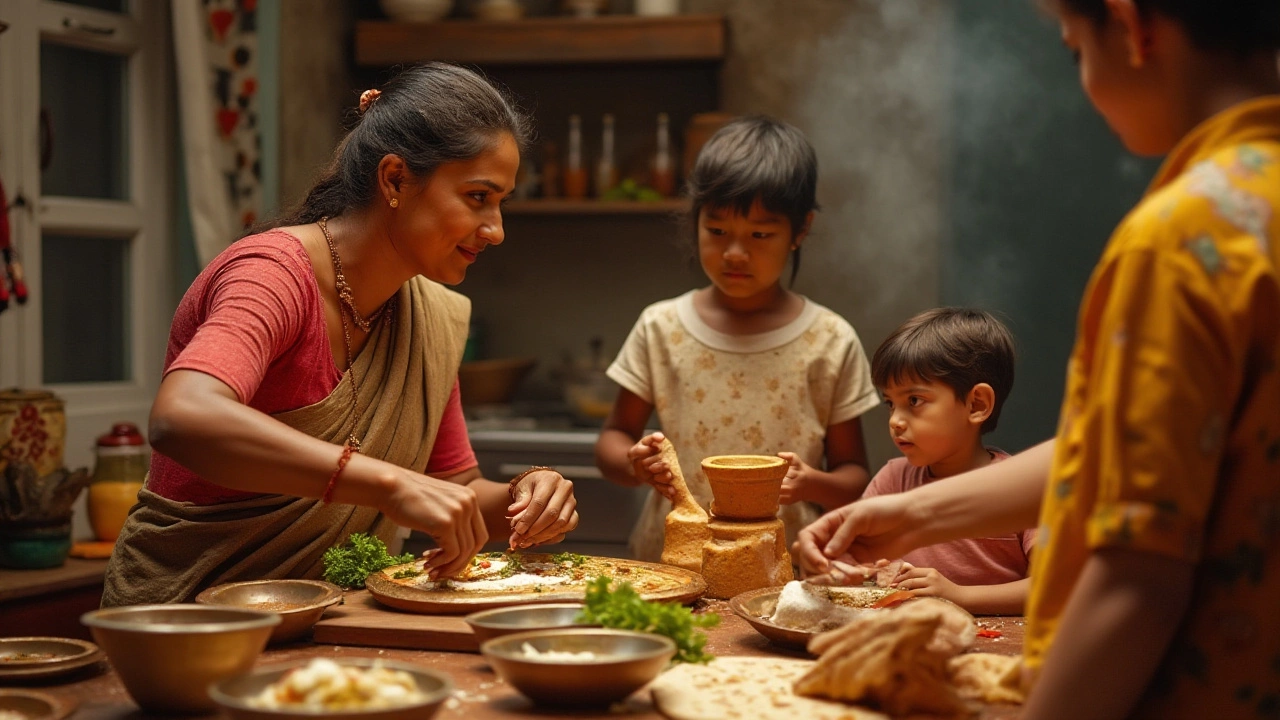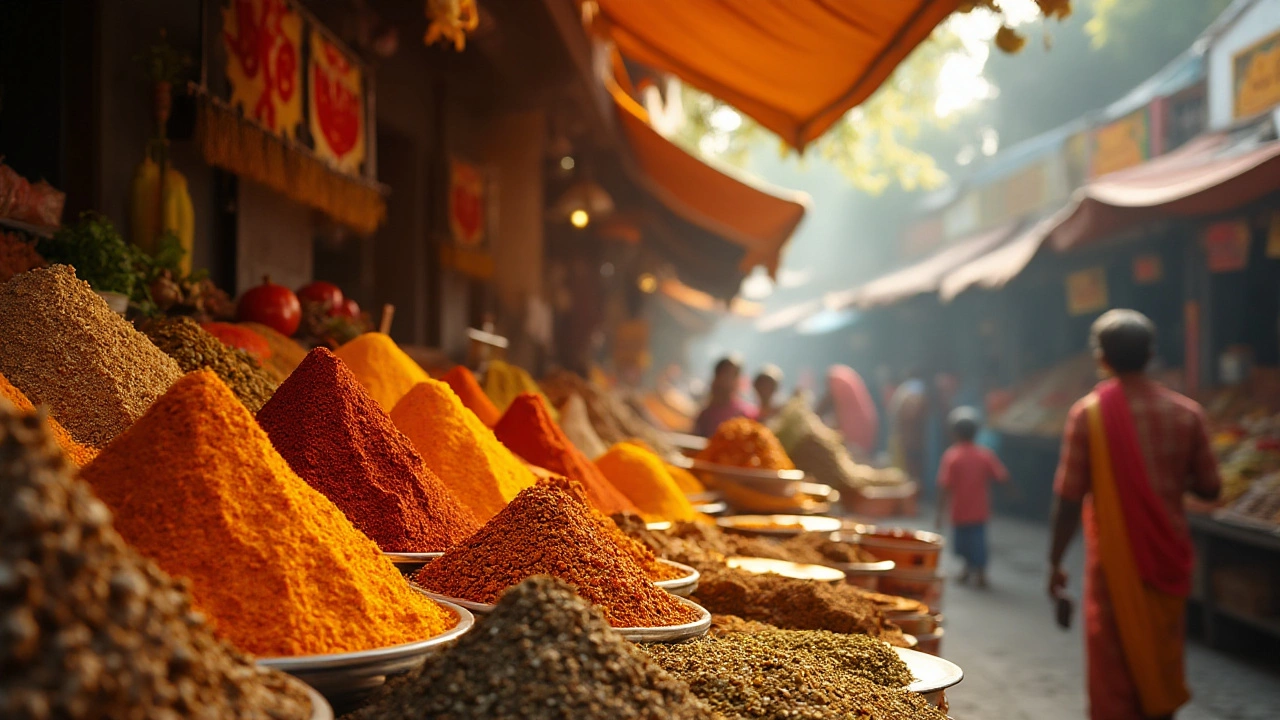When you think of Indian cuisine, a symphony of flavors, spices, and aromas likely comes to mind. It's a culinary journey that spans vibrant street snacks to elaborate festive meals, each bringing its own allure and story to the table. Generations have honed these recipes, blending tradition with innovation to create foods that tell stories as old as time and as fresh as today's kitchen.
Whether it's the creamy richness of a butter chicken or the spicy zing of a masala dosa, Indian food offers a palette of tastes waiting to be explored. These dishes don't just tantalize the taste buds; they speak of regions, cultures, and history. In this article, we'll travel across India, highlighting some of the country's most beloved dishes, offer tips for recreating them in your own home, and spill a few secrets to elevate your Indian cooking game. Get ready to embark on this flavorful adventure!
- The Rich Diversity of Indian Food
- Top Tasty Indian Dishes You Must Try
- Essential Spices for Authentic Indian Flavor
- Quick and Easy Indian Recipes for Beginners
- Tips for Enhancing Your Indian Culinary Skills
The Rich Diversity of Indian Food
Imagine stepping into a world where every meal is an experience that tells a story, where each bite speaks of a region and whispers tales of ancient trade routes, migrations, and the intermingling of cultures. That's Indian cuisine for you—a culinary tapestry as vibrant and varied as the country itself. From the lush valleys of Kashmir in the north to the sun-drenched coasts of Kerala in the south, India's food reflects its diverse geography, climate, and cultural richness. Each state, and often each city, brings its own signature dish to this grand buffet, each distinct yet carrying the unmistakable essence of India. Whether it's the fiery curries of the east or the buttery naans from the north, there's something to tantalize every palate.
In India, food is sacred. It is not just sustenance; it embodies celebration and tradition, and reflects local values. Take Bengal, for instance, where fish and rice form the heart of their diet due to the region's proximity to rivers and the sea. The Bengalis have a penchant for delicate flavors, often pairing sweet and savory elements like mustard prawn curry or the famous sweet yogurt called 'mishti doi.' Move to the Punjabi heartland, and the cuisine shifts dramatically to rich, spicy indulgence—think creamy butter chicken and the ubiquitous tandoori roti that accompany thick lentil daals. Flavorful dishes abound, partly due to Punjab’s agricultural affluence which provides fresh ingredients in abundance, allowing cooks to experiment and perfect a wide array of recipes.
Consider the vegetarian delights of Gujarat in the west, and you'll see an emphasis on subtle sweetness balanced with tang, making simple ingredients sing with flavor. And in Tamil Nadu, dosa—a crisp, rice-batter crepe—is just the start. Spiced fillings and accompanying chutneys make this quintessential southern dish a staple that's adored nationwide. Indeed, each bite of Indian cuisine is like reading a chapter of an unending tale, and the spices are the secret language that unlocks its meanings. Renowned food writer Madhur Jaffrey notes, "Indian food is about balancing not just flavors but also the art of maintaining a delicate dance between health and indulgence."
"Indian food is about balancing not just flavors but also the art of maintaining a delicate dance between health and indulgence." - Madhur Jaffrey
Indian cuisine wouldn't be as tantalizing without its array of spices. Each spice comes with its own heat and aroma, used meticulously to enhance the primary ingredient rather than overpower it. The intriguing mix might include cumin, coriander, turmeric, cardamom, or even the exotic saffron, each carrying healing properties heralded in Ayurveda. Every ingredient has its place and purpose, contributing not just flavor but also depth and energy to the meal. Did you know that there's also a harmonious sequence to how spices are introduced in Indian cooking? For instance, whole spices are often added to the hot oil at the beginning to release their essential oils, creating the foundational flavor base. With each step, the dish grows more complex and layered, embodying centuries of knowledge and tradition.
What makes Indian food truly remarkable is its adaptability and the growing popularity it enjoys worldwide. Its inherent flexibility allows chefs to reinterpret traditional dishes with modern touches while still preserving the heart of age-old recipes. Traveling across India is like a culinary pilgrimage, each region offering its unique take on staple foods, enhancing them with distinct regional spices and methods. Indian recipes have also evolved to suit contemporary lifestyles, with dishes now crafted for quick meals that maintain traditional flavors, suitable for people navigating busy schedules. Such innovation keeps Indian cuisine alive, dynamic, and ever-evolving, much like the country itself.
Top Tasty Indian Dishes You Must Try
Embarking on a culinary journey across India is like opening an ancient book filled with vibrant illustrations and mysterious tales. Each dish tells a story, weaving together the varied landscapes and histories of this diverse country. From the lush green valleys of Kerala to the bustling cities of Delhi, Indian cuisine offers a rich tapestry of flavors that are both intoxicating and unforgettable. Let's delve into some of these delicious adventures, starting with the ever-popular Butter Chicken. Hailing from Delhi, this dish combines tender pieces of chicken with a creamy tomato-based sauce, enriched with aromatic spices to create a symphony of taste. Developed as a way to use leftover chicken, its rich and satisfying flavors now captivate food lovers across the globe.
Next on our list is the spicy and crispy Masala Dosa, a staple originating from the southern part of India. Often referred to as the Indian pancake, the dosa's magic lies in its rice-and-lentil batter that is fermented overnight. The batter is then spread thin on a hot griddle, achieving a perfect crispy texture that cracks under the slightest touch. Inside, it conceals a spiced potato filling that adds a comforting contrast to the crisp outer layer. Whether you're in a bustling street stall in Chennai or a cozy restaurant in Mumbai, you will find each bite of masala dosa brings you closer to the heart and soul of Indian cuisine.
Another dish not to be missed is the flavorful Biryani, a blend of basmati rice, vegetables or meat, and a fragrant mix of spices. This dish is often celebrated as the ultimate comfort food, offering both a satisfying depth of flavor and a fragrant aroma that fills the room. With its origins tracing back to Persian influence, biryani has evolved across Indian regions, with each serving its own distinctive version from the spicy culinary styles of Hyderabad to the subtle notes of the Kolkata biryani.
"The diversity of Indian food is really stunning, and the spicing is just extraordinary." - Yotam Ottolenghi
Perhaps the magic of Indian food shines brightest with the vibrant and colorful Palak Paneer. This North Indian delight balances the richness of paneer, or Indian cottage cheese, with the earthy fragrance of spinach cooked with inviting layers of spices. The vivid green color promises not only a feast for the eyes but a journey through India’s embrace of vegetarian cuisine. It’s a beautiful representation of how traditional Indian food harmonizes flavors and textures into something utterly delightful.
A dish that often steals the show is the smoky and spicy Tandoori Chicken. Marinated in a blend of yogurt and spices, it is cooked in a tandoor, a traditional clay oven that imparts a unique smoky flavor. The chicken develops a crispy exterior while remaining juicy on the inside—a true culinary masterpiece that is sure to please any palate.
To truly understand these dishes is to experience them—to savor each bite and let the flavors transport you. Indian food carries with it centuries of traditions, influences, and endless creativity. Its beauty lies in its ability to adapt yet remain true to its roots. By exploring these quintessential dishes, you’re not just embracing new flavors but joining a rich tapestry of culture that may well change the way you view your next meal.

Essential Spices for Authentic Indian Flavor
To understand Indian cuisine, one must first understand the heart of its flavors: the spices. India is famed for its use of spices, a practice that has not only influenced cuisines across the globe but has also been part of international trade for centuries. There is a poetry in the blend of spices in Indian cooking, each playing a part in the chorus of flavor and aroma. Let's dive deep into the essential spices that define Indian recipes and bring them to life with their unique tastes and vibrant colors.
Among the foundational spices in Indian kitchens, turmeric stands out with its brilliant yellow hue and earthy, slightly bitter flavor. It's widely known not just for its color but also for its medicinal properties, often used in traditional remedies to boost immunity and promote overall health. Cumin, with its warm and nutty aroma, is another staple, providing an unmistakable depth to dishes. Its presence is essential in seasoning meats and lentils, often used whole or ground. Coriander, harvested from the cilantro plant, offers a sweet and citrusy flavor, complementing a wide array of dishes from curries to soups.
A spice that adds a fiery kick to many Indian dishes is chili powder. Its etymology stems from the indigenous names given by early explorers and reflects the fiery intensity it imparts to flavorful dishes. However, the heat of Indian food is not limited to chilies alone. There are countless varieties of peppers used across different regions, each adding their own flavor profile and heat level. Cardamom, often called the queen of spices, provides a sweet, floral fragrance and is a key ingredient in both savory dishes and desserts like kheer and traditional chai.
"Turmeric, cumin, and coriander are the triumvirate of spices that you'll find at the core of India's rich culinary tapestry," explained Anjali Pathak, a renowned chef and cookbook author.
Garam masala, literally translated to 'hot spices,' is a blend that captures the essence of Indian cooking. It's a warming mix that can have anywhere from five to thirty ingredients, commonly including cloves, cinnamon, nutmeg, and peppercorns. This spice blend is typically added at the end of cooking to preserve its aromatic qualities. Its versatility makes it a popular choice in a variety of recipes, from simple curries to complex biryanis.
For those seeking the umami flavors, asafetida, a pungent spice, is often used. Known as 'hing' in Hindi, this spice is used sparingly but can drastically enhance a dish's flavor profile, especially in vegetarian recipes. Fenugreek seeds, with their bittersweet flavor, often appear in pickles and fish curries, bringing a distinctive taste that is both unique and essential. A balanced combination of these spices can truly transform traditional Indian food, making each meal a delightful experience of aroma and taste.
To fully appreciate Indian spices, one might examine their nutritional benefits and role in folk medicine. A study conducted in 2022 indicated that regular inclusion of these spices in the diet is linked to reduced inflammation and improved metabolic health, making them not only essential for flavor but beneficial for well-being too. Such findings only add to the reverence with which these spices are regarded in Indian culinary traditions. In a world where flavors can sometimes blur into sameness, spices bring distinction and depth, making every dish a captivating adventure in taste.
Quick and Easy Indian Recipes for Beginners
Embarking on the journey to explore Indian cuisine might seem daunting at first. With its myriad of spices and techniques, one could easily feel overwhelmed. But don't worry! Starting with some simple and quick recipes can help ease you into this world of flavors. The beauty of Indian food lies in its versatility, allowing even beginners to create dishes bursting with taste. Let's take a look at some easy favorites that you can whip up in no time.
First up, we have the all-time favorite, Vegetable Curry. This is a dish that embodies everything people love about Indian food: colorful, spicy, and incredibly wholesome. Start by warming some oil in a pan and tossing in cumin seeds until they sizzle. Add chopped onions, ginger, and garlic, stirring until golden brown. This is your base. Add your choice of vegetables such as potatoes, carrots, and peas. Season with turmeric, coriander, and garam masala. Pour in coconut milk to create a creamy texture and simmer until the veggies are tender. Serve hot with some naan or rice and savor the simplicity of complex flavors.
"Cooking is love made visible," said the famous Indian chef, Madhur Jaffrey. It's true with Indian recipes where every bite tells a story.
Another easy and quick delight is the humble Dal Tadka. This lentil-based dish is not only nutritious but also budget-friendly. Begin by boiling lentils until soft. In a separate pan, heat some ghee or oil and add mustard seeds until they pop. Introduce chopped garlic, tomatoes, and green chilies along with turmeric and cumin powder. Pour this fragrant mixture over the cooked lentils and stir well. The result is a comforting bowl of lentils, perfect when paired with basmati rice. It's heartwarming, easy to prepare, and a definite staple in Indian households.
Don't miss out on experimenting with the street food classic, Chole Bhature. Ready in under an hour, it's a treat that promises a hearty satisfaction. Cook chickpeas until tender. In a pan, blend together tomatoes, onions, garlic, and ginger to form a paste. Add this to heated oil, incorporating a blend of spices such as chili, coriander, and amchur powder. Once the mixture thickens, stir in the chickpeas and let it simmer gently. Pair it with fluffy fried bread known as Bhature, and dive into the feast.
For a quick sweet treat, try making some simple Gajar Halwa. Grate carrots and cook them with cardamom-infused milk. Once it thickens, add sugar and ghee, stirring until the mixture caramelizes slightly. Garnish with nuts and enjoy a sweet finish to your culinary adventure. Each bite is a harmonious blend of sweet, spicy, and nutty flavors that showcase the magic of Indian sweets.
Regardless of where you start, remember that practicing these recipes will not only improve your skills but also connect you with the richness of Indian recipes that are celebrated globally. Before you know it, you'll be ready to take on more complex dishes, each bearing the essence of vibrant Indian cuisine.

Tips for Enhancing Your Indian Culinary Skills
Diving into the vibrant world of Indian cuisine is an exciting adventure, but it comes with its own set of challenges. The secret to mastering these flavorful dishes lies not just in ingredients but in understanding the essence of Indian cooking itself. One key tip is to get familiar with essential spices. Spices like cumin, turmeric, cardamom, and garam masala are the backbone of many Indian recipes. A well-stocked spice rack with these essentials is your best friend in the kitchen. Each spice has a distinct aroma and purpose, and getting to know their roles will significantly influence your culinary results.
Another useful approach is to practice the art of tempering, or as the locals say, "tadka." It’s a technique that involves frying spices in hot oil or ghee to release their flavors, often used as the finishing touch in Indian dishes. Proper tempering can transform a dish, adding a depth of flavor that enchants the palate. Remember, practice makes perfect, so don’t shy away from experimenting with different combinations of spices and cooking methods.
Freshness is paramount in Indian cooking. Whenever possible, use fresh ingredients. The taste, aroma, and texture of your dish will be noticeably different when you cook with freshly ground spices, homemade pastes, and seasonal vegetables. Fresh herbs like coriander, mint, and curry leaves not only garnish your dish but also elevate its flavors to new heights. Invest time in learning the nuances of these herbs, and perhaps even cultivate a small herb garden at home.
Now let's talk about time management and preparation. Prepping your ingredients and spices before you start cooking is a critical step. Measure your spices and prepare any pastes ahead of time. In a busy world, mise en place might seem tedious, but it allows for smooth, stress-free cooking. This preparation also ensures that you don't burn any spices, which can happen easily in the flurry of the cooking process.
Getting comfortable with traditional cooking methods like using a tandoor or claypot can make a difference in flavor and texture. While modern conveniences are wonderful, there's something unique about the smoky flavor imparted by traditional methods. Don't fret if you don’t have access to traditional tools, though. A simple skillet or pan can still do wonders if you apply the age-old techniques properly.
Lastly, trust your senses. As you cook Indian recipes, rely on taste, smell, and feel. Your senses are finely tuned tools that can guide your cooking journey. A pinch of salt or a splash of lime can turn your dish from ordinary to extraordinary. As Madhur Jaffrey famously said, "Always trust your own taste" and don't hesitate to modify recipes to match your palate preferences. With each dish you create, you'll grow more adept at the wonderful craft of Indian cooking, eventually feeling at home within its vibrant, flavorful world.
